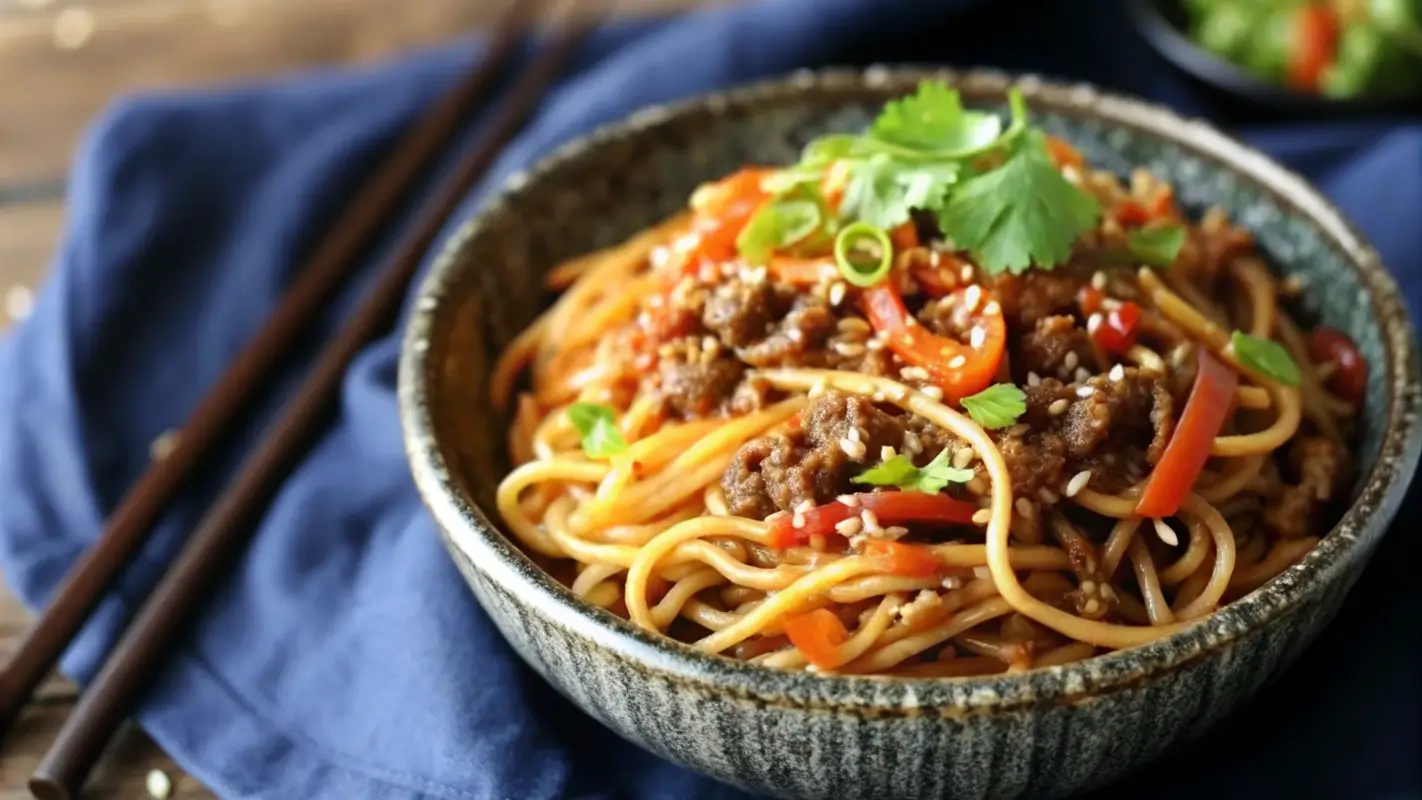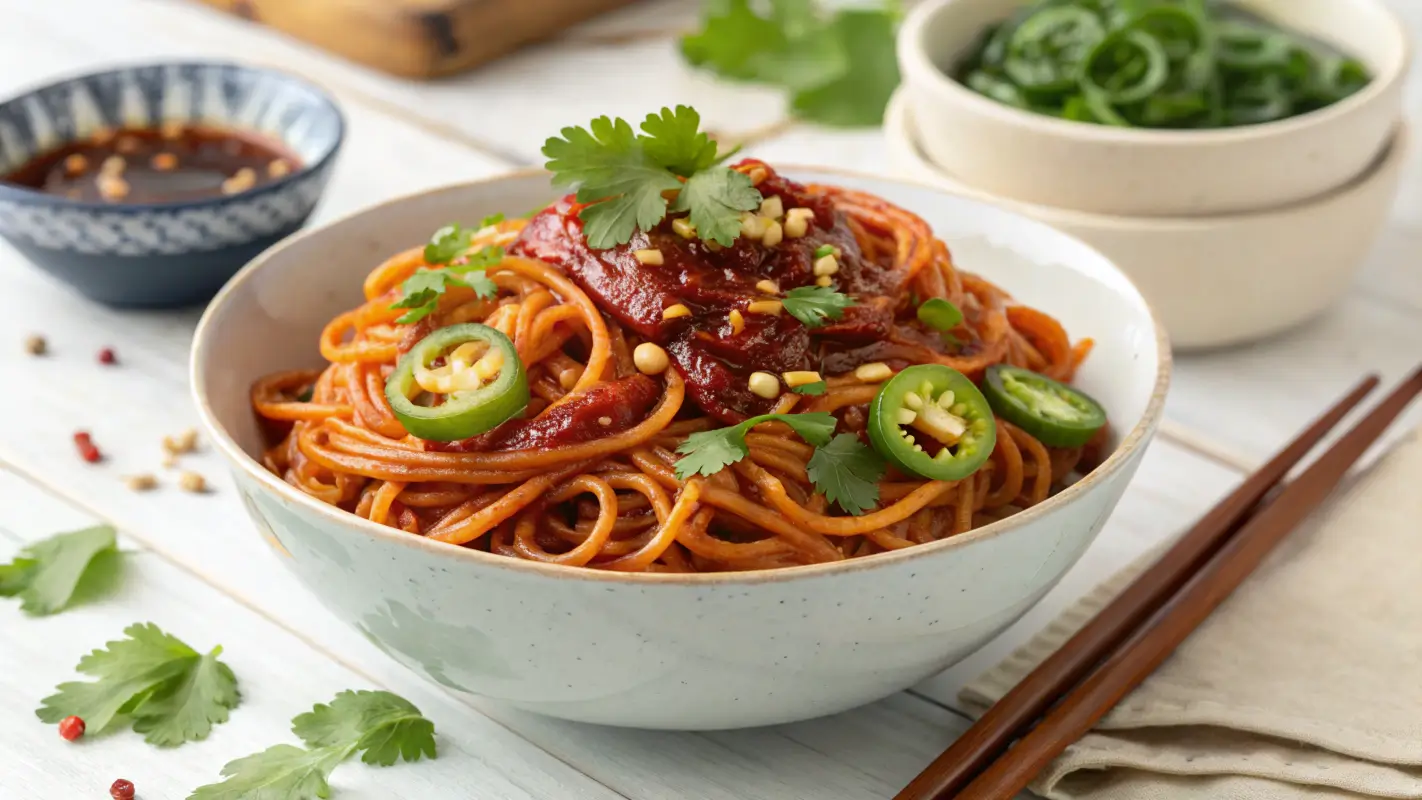Table of contents
Have you ever found yourself sitting in a cozy restaurant, a steaming plate of Mongolian noodles in front of you, and wondered, What’s in this fantastic dish? If so, you’re not alone! For a good reason, Mongolian noodles are a favorite—they’re bold, satisfying, and packed with a perfect blend of sweet, savory, and smoky flavors.
So, what’s in this kitchen? I wonder? Let’s roll up our sleeves and dig into everything Mongolian noodles bring. Spoiler alert: You don’t have to be a professional chef to whip up this dish at home. You can recreate this takeout favorite right in your kitchen with just a few essential ingredients and simple techniques.
But wait, there’s more! I’ve also included a handy FAQ section at the end to tackle those burning questions we’ve all had about Mongolian noodles. Ready to dive in? Let’s dive in and get cooking!
For a deeper exploration of Mongolian noodles, including their origins and variations, you might find this article insightful: Mongolian Beef Noodles.
The Basics
What Are Mongolian Noodles?
First things first: What exactly are Mongolian noodles? Interestingly, despite the name, they do not originate from Mongolia. Instead, the dish is inspired by Asian fusion and has strong ties to Chinese-American cuisine. Mongolian barbecue restaurants, which stir-fry meats, vegetables, and sauces on a large, flat skillet, played a significant role in popularizing it. Eventually, noodles became a natural addition, perfectly designed to soak up all those delicious flavors.
Mongolian noodles typically feature a delightful combination of chewy, hearty noodles, a protein like beef or chicken, fresh vegetables, and a sauce that strikes the perfect balance between sweet and savory. For example, the sauce often includes soy sauce, garlic, ginger, and hoisin—plus a little heat for those who enjoy spicy food. It’s a one-dish wonder that’s quick to make, packed with bold flavors, and easily customizable to suit your taste. Learn more about the perfect pairing in this recipe for Mongolian Ground Beef Noodles.
What Are Mongolian Noodles Made Of?
Let’s examine the ingredients that make Mongolian noodles. These are the dish’s building blocks, and they’re surprisingly simple!
The Noodles
The noodles are, without a doubt, the heart of the dish. They’re what make Mongolian noodles so comforting and satisfying. Most recipes call for:
- Lo Mein Noodles: These thick, chewy noodles made from wheat flour are excellent for soaking up the sauce without becoming mushy.
- Rice Noodles: A fantastic gluten-free alternative. They’re light and slightly different in texture but work beautifully.
- Egg noodles are another great choice. They are rich, silky, and slightly buttery.
Pro Tip: If you don’t have access to Asian noodles, spaghetti or linguine can work in a pinch. Just cook them slightly underdone so they don’t get too soft when stir-fried.
The Protein
Classic Proteins for Mongolian Noodles
Protein is the next critical component. Mongolian noodles are versatile, so you can use just about any protein you love. Here are some classic choices:
- Beef: Thinly sliced flank steak is a tender, flavorful option that pairs perfectly with the sauce.
- Chicken: Boneless, skinless chicken breasts or thighs work great. Thighs are juicier, while breasts are leaner.
- Pork: Slightly fatty cuts like pork shoulder or belly add richness to the dish.
Plant-Based and Seafood Options
If you prefer a lighter or plant-based approach, you can try these alternatives:
- Shrimp: A light, delicious option for seafood lovers. Be careful not to overcook it—it only needs a few minutes.
- Tofu: Extra-firm tofu is an excellent plant-based protein that holds up well during stir-frying.
Pro Tip: Marinate your protein briefly in soy sauce, a splash of sesame oil, and a pinch of cornstarch to tenderize it and add extra flavor.

The Vegetables
Vegetables play a vital role in Mongolian noodles. Not only do they add vibrant color and satisfying crunch, but they also provide a healthy dose of nutrients. Here’s a look at some standard options you can include:
Traditional Vegetables
- Bell Peppers: Red, yellow, or green peppers bring a sweet, crisp bite.
- Carrots: Thinly sliced or julienned, carrots add natural sweetness and a pop of color.
- Onions: Yellow, white, or red onions provide a savory base flavor.
Creative Additions
Feel free to get creative with your veggie choices!
- Zucchini: This tender vegetable absorbs the sauce beautifully.
- Mushrooms: Shiitake or button mushrooms add an earthy flavor.
- Other Options: Snow peas, broccoli florets, or shredded cabbage can work wonderfully, too.
Pro Tip: Slice all vegetables thinly to ensure they cook quickly and evenly.
The Sauce
The sauce is the real star of Mongolian noodles. Here’s what you’ll need to create the perfect balance of sweet, savory, and spicy:
Key Ingredients
- Soy Sauce: The salty, umami-packed base.
- Hoisin Sauce: Adds sweetness and a tangy depth of flavor.
- Oyster Sauce: Optional but highly recommended for extra savoriness.
- Garlic & Ginger: Freshly minced for bold, aromatic notes.
- Brown Sugar: Adds sweetness to balance the salty elements.
- Red Pepper Flakes or Chili Paste: Adjust the heat to your spice preference.
Customization Options
You can adapt this sauce endlessly to suit your taste:
- Would you prefer it sweeter? Add more brown sugar.
- Is it spicier? Toss in extra chili paste.
You’re the boss here—adjust it to your taste!
The Oil
Oil is essential for stir-frying and prevents ingredients from sticking to the pan. Common choices include:
- Sesame Oil: Adds a nutty aroma and authentic Asian flavor.
- Neutral Oils: Vegetable or canola oil works well for high-heat cooking.
I included subheadings such as “Classic Proteins,” “Plant-Based and Seafood Options,” “Traditional Vegetables,” and “Creative Additions” to organize the content into smaller, more digestible sections. These changes improve readability and create a more enjoyable experience for readers.
This recipe is adapted from Mongolian Ground Beef Noodles.

How to Make Mongolian Noodles at Home
Ready to try your hand at making Mongolian noodles? It’s easier than you might think! Here’s a step-by-step guide:
- Prep Your Ingredients: Slice your protein and vegetables thinly so they cook evenly. Whisk together the sauce ingredients in a small bowl.
- Cook the Noodles: Boil your noodles according to the package instructions. Drain and set them aside.
- Stir-Fry the Protein: Heat oil in a wok or large skillet over medium-high heat. Cook the protein until browned and cooked through. Remove from the pan and set aside.
- Sauté the Vegetables: Add more oil to the pan, then stir-fry the vegetables until they’re tender-crisp.
- Combine Everything: Toss the noodles, protein, and sauce in the pan. Stir until evenly coated and heated through.
- Serve and Enjoy. Garnish with chopped green onions and sesame seeds for an extra flavor and presentation.
A Quick History of Mongolian Noodles
Despite the name, Mongolian noodles aren’t a traditional Mongolian dish. Instead, they’re inspired by the concept of Mongolian barbecue, which was created in Taiwan in the 1950s and popularized in the United States. The dish we know today has evolved into a fusion of Chinese-American flavors, with noodles, proteins, and sauces tailored to suit various tastes. Read about the origins of Mongolian noodles.
Tips to Make Mongolian Noodles Faster
- Pre-Cut Veggies: Save time by using pre-sliced vegetables from the grocery store.
- Rotisserie Chicken: Shred a store-bought rotisserie chicken for a quick protein option.
- Pre-Made Sauce: Mix up a batch of sauce and store it in the fridge for up to a week.
- One-Pan Cooking: Keep it simple by using a single wok or skillet for everything.
FAQs About Mongolian Noodles
What kind of noodles are in Mongolian barbecue?
So, when you’re whipping up some Mongolian barbecue, you’ll want to grab those udon noodles. They soak up that rich beef broth perfectly. First, brown the ground beef in hot oil with ginger and garlic. After about 2 minutes, add your marinade and let it sear for that flavor blast.
Once the beef is nice and tender, add the cooked noodles and mix well with low-sodium soy sauce. If you’re feeling adventurous, add some ground turkey, too! Let it cook for about 15 minutes until that sauce is thick and glossy.
Finally, add the drained noodles to your pan and combine the beef with the Mongolian sauce. Don’t forget to toss in some onions and serve it all up! This noodle dish is a total win; I loved this recipe from Marion’s Kitchen! Explore variations in this Mongolian beef noodle recipe.
How many carbs are in Mongolian noodles?
If you’re trying Mongolian noodles with ground beef, you might wonder how many noodles and carbs they contain. Typically, these noodles are stir-fried at high heat with minced garlic for a pop of flavor. I’ll make a quick recipe using low-sodium soy sauce and sweet soy to keep it tasty yet healthy!
First, heat the oil to medium heat and add beef to combine the ingredients. Stop them cooking after a minute before flipping to keep that tender beef vibe going. After cooking the meat, I’ll toss everything together and serve over noodles. It’s all about that savory stir-fry sauce that thickens nicely!
When you’re done, those noodles like to come apart, making it easy to enjoy. Remember, the beef and sauce combine tender, giving you a delicious bite every time. I can’t wait to share the recipe with you all!
What are brown noodles made of?
I’m making this dish with ground beef Mongolian noodles and rice noodles. First, cook the pasta until it’s perfect, then add the onion when the oil is hot. This dish is versatile, and your family will love it!
Next, prepare the sauce using low-sodium soy sauce. It should take about half a minute for the sauce to thicken. Then, toss in the noodles—but watch out—they might fall! I’d love to know how you liked it.
With all these ingredients, you’ll be inspired to cook some fantastic Asian cuisine. Just fry everything together, and you’re good to go! Thanks for sharing this wonderful recipe!
What were ancient Chinese noodles made of?
Ancient Chinese noodles were pretty cool! They were usually made from wheat or rice; rice noodles can come apart nicely in a dish. When I cook, I’ll make a tasty stir-fry with some low-sodium soy sauce once the sauce has thickened. It takes just a few minutes to get everything ready. Thank you for sharing this delicious tradition!
Conclusion Mongolian Noodles
So, if you’re looking for a quick and tasty dinner idea for a weeknight, try these Mongolian Noodles! You can whip up a delicious and healthier dish with some low-sodium soy sauce. Just make sure your noodles come apart quickly when you’re cooking them!
Gather all the ingredients you’ll nee— trust me, it’s super simple. I’ll make this Asian-inspired dish in no time, and you can do it too! It’s a fun way to spice up your weeknight meals!





